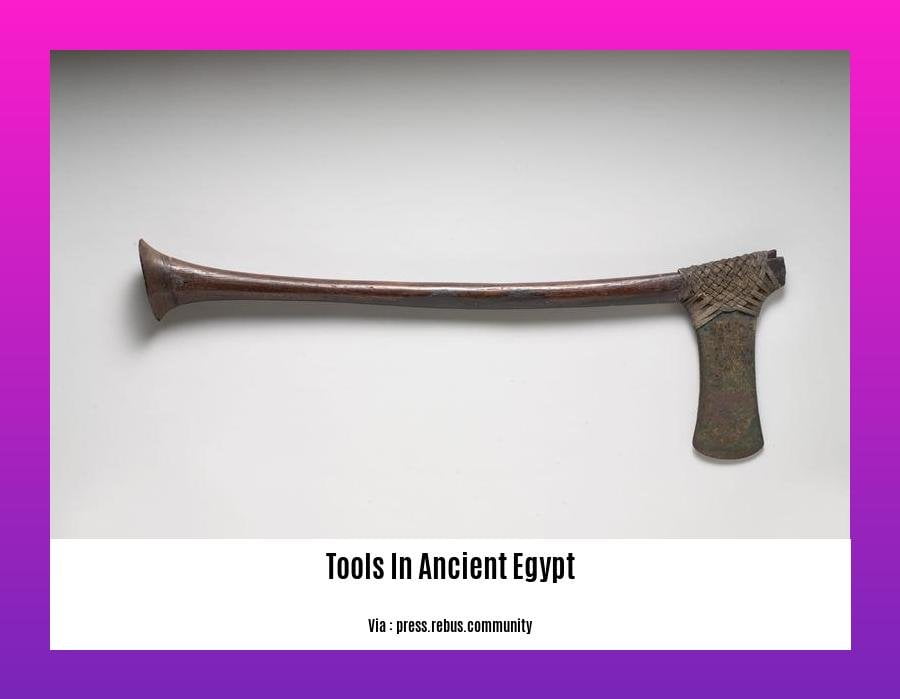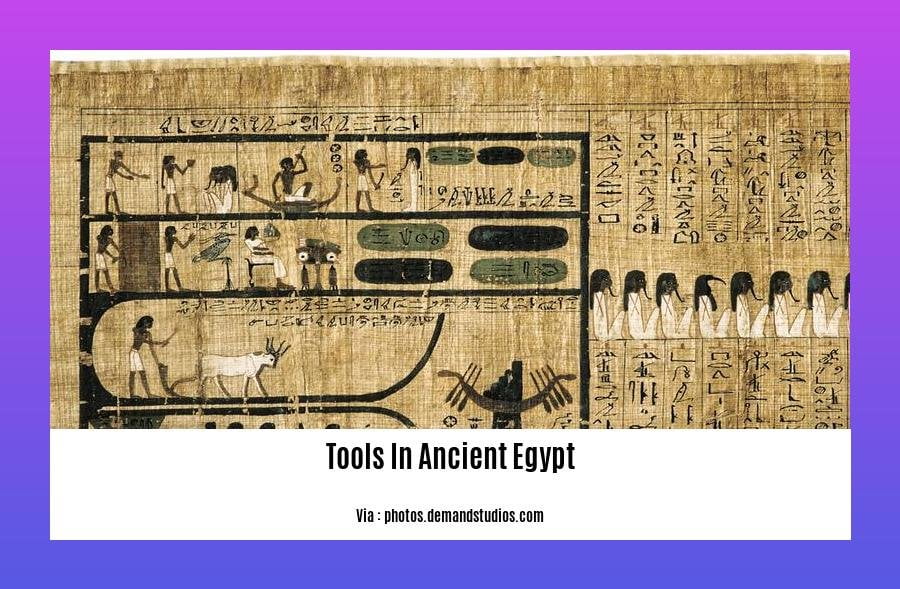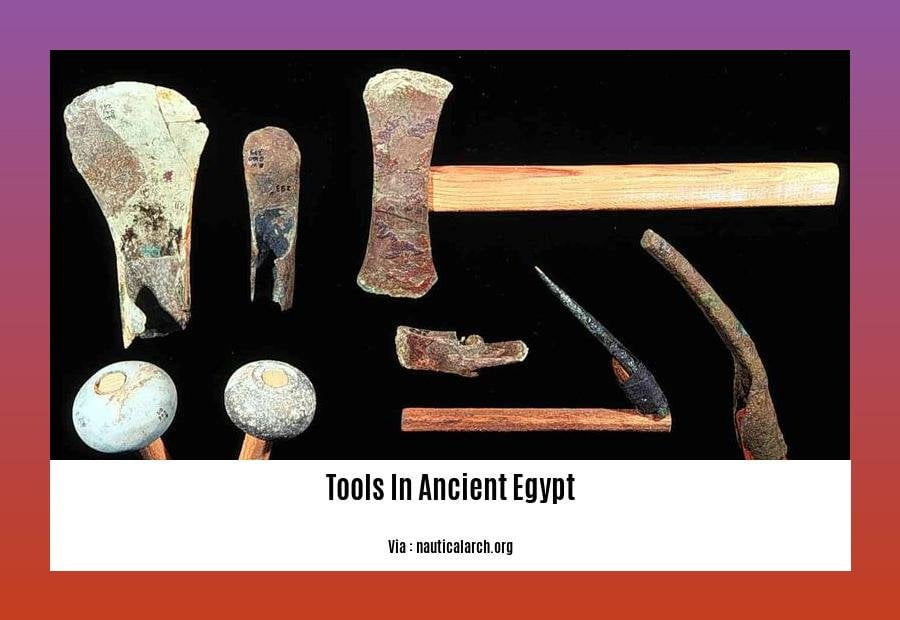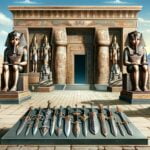In the heart of the Nile Valley, where the sands of time hold secrets untold, lies a testament to human ingenuity—Tools in Ancient Egypt: Exploring the Craftsmanship and Ingenuity of an Ancient Civilization. From the pyramids that pierce the sky to the intricate hieroglyphics that tell tales of old, ancient Egypt’s tools and weapons reveal a world of artistry, adaptability, and innovation that continues to captivate and inspire.
Key Takeaways:
- Ancient Egyptians used tools made from numerous materials, including copper, iron, wood, bronze, ivory, bone, and stone.
- Common tools included flint tools, wooden cramps, axes, bronze chisels, adzes (similar to axes but with perpendicular blades for engraving), chisels (for sculpting and inscriptions), drills (for constructing holes), and hand saws (for splitting wood or stone).
- Egypt’s location near the Nile River promoted farming, which demanded efficient tools for cultivation and irrigation.
- For more information, see Ancient Egyptian Tools – Facts About Ancient Egypt and Tools Used in Ancient Egypt: Chisels, Hammers, Axes and More!
Tools in Ancient Egypt: Unveiling the Craftsmanship and Ingenuity of an Ancient Civilization

Step into the world of ancient Egypt, where craftsmanship and ingenuity shaped the lives of people for millennia. Tools in ancient Egypt played a pivotal role in the development of one of the most remarkable civilizations in history. They were not mere objects but testaments to the skill and innovation of the Egyptian people.
Materials and Techniques:
The ancient Egyptians fashioned their tools from readily available materials such as copper, iron, wood, bronze, ivory, bone, and stone. Each material had its unique properties and was suited to specific tasks. Copper, bronze, and iron, for instance, were used for making durable tools like chisels and axes, while wood was ideal for handles and farming implements. Stone, with its inherent hardness, was reserved for tools like grinding stones and mace heads.
Common Tools:
The tools in ancient Egypt were as diverse as the tasks they performed. Farmers relied on flint tools, wooden cramps, and hoes to cultivate their fields and manage irrigation systems along the fertile Nile River. Craftsmen employed axes, bronze chisels, and adzes to shape wood and stone, while artists used chisels and hand saws to create intricate sculptures and inscriptions that still captivate us today.
Significance in Society:
The tools in ancient Egypt were more than just utilitarian objects; they held cultural and symbolic significance. The choice of materials, the craftsmanship involved, and the intricate designs often reflected the status and beliefs of the user. For example, copper tools were associated with the god Horus, while gold tools were reserved for royalty. The tools also played a vital role in religious rituals and ceremonies, connecting the mortal world with the divine.
Conclusion:
The tools in ancient Egypt were a testament to the ingenuity, skill, and creativity of the ancient Egyptian civilization. These tools were not just objects; they were instruments of progress, creativity, and cultural expression. By studying these tools, we gain a deeper understanding of the daily lives, technological advancements, and artistic achievements of one of the world’s most enduring civilizations.
Did you know that ancient Chinese soldiers had unusual ancient Chinese weapons like the Nine-section whip and the Tiger-toothed disk?
In ancient Egypt, craftsmen had a wide range of skills, from sculpting statues to building pyramids.
Explore the daily lives and remarkable contributions of craftsmen in ancient Egypt.
Discover the capital of ancient Egypt and its significance as the center of political and religious power.
Ancient Egyptian Tools

Imagine a world without sophisticated machinery or modern technology. The ancient Egyptians thrived in such a world, relying on their ingenuity and craftsmanship to build pyramids, cultivate crops, and create remarkable works of art. Their tools, crafted from readily available materials like wood, stone, copper, and bronze, were essential to their daily lives and played a pivotal role in shaping their civilization.
Key Takeaways:
- Diverse Toolset: The ancient Egyptians utilized a wide range of tools, each meticulously designed for a specific purpose.
- Nile River Influence: Proximity to the Nile shaped their tool development, driving the need for efficient agricultural tools.
- Woodworking Mastery: Wood was a versatile material for the Egyptians, used to craft furniture, coffins, and agricultural implements.
- Stoneworking Expertise: Egyptian masons wielded hammers, chisels, and wedges to cut through granite, demonstrating their stoneworking prowess.
- Farming Tools: Sickles and grinding stones were integral to harvesting and processing grain, the lifeblood of their civilization.
- Irrigation Techniques: Agricultural tools like cow-powered plows facilitated effective farming and irrigation practices.
The ancient Egyptians’ resourcefulness and adaptability are evident in their tools. From simple wooden hoes to intricate bronze chisels, their craftsmanship reflects a deep understanding of materials and their properties. Their tools were not merely utilitarian objects but also testaments to their ingenuity, creativity, and unwavering pursuit of progress.
In the hands of skilled artisans and laborers, Ancient Egyptian Tools transformed raw materials into architectural marvels, intricate hieroglyphics, and stunning works of art that continue to captivate us today. Their legacy serves as a reminder of the enduring power of human innovation and the transformative role of tools in shaping civilizations.
Relevant URL Sources:
- Ancient Egyptian Tools – Facts About Ancient Egyptians
- Ancient Egyptian technology
Tools In Ancient Egypt And Their Uses
Journey with us through time to explore the fascinating world of ancient Egyptian tools, uncovering the remarkable craftsmanship and ingenuity of this ancient civilization.
Key Takeaways:
- The ancient Egyptians skillfully utilized tools made from diverse materials, ranging from copper, iron, wood, bronze, ivory, and bone to stone.
- Their tools encompass flint tools, wooden cramps, axes, bronze chisels, adzes, chisels, drills, and hand saws, serving a wide range of purposes.
- The proximity of the Nile River played a pivotal role in shaping their tool development, driving the need for efficient agricultural implements.
In the hands of the ancient Egyptians, tools were more than mere objects; they were instruments of innovation and progress, enabling them to thrive in a world devoid of sophisticated machinery. Their ability to transform raw materials into architectural wonders, hieroglyphic inscriptions, and captivating works of art serves as a testament to their ingenuity and creativity.
1. Agricultural Tools: Cultivating the Land
The ancient Egyptians relied heavily on agriculture, and their tools reflected this focus. Sickles and grinding stones were essential for harvesting and processing grain, while cow-powered plows облегчили effective farming and irrigation practices.
- Sickles: These curved blades, crafted from sharp materials, were used to reap crops efficiently during harvest season.
- Grinding Stones: Grain processing was made possible through the use of grinding stones, manually operated to produce flour.
- Cow-powered Plows: These plows, pulled by sturdy cows, facilitated efficient soil preparation and planting.
2. Architectural Tools: Constructing Enduring Structures
The enduring pyramids and temples of ancient Egypt stand as testaments to their architectural prowess. Their tools, including hammers, chisels, and wedges, enabled them to cut through granite and shape colossal blocks with remarkable precision.
- Hammers: With hammers, they skillfully shaped stones and carved intricate designs.
- Chisels: Chisels allowed them to carve hieroglyphics into stone, preserving their history and beliefs.
- Wedges: Wedges were instrumental in splitting large stones into manageable pieces for construction.
3. Artistic Tools: Transforming Ideas into Masterpieces
The ancient Egyptians possessed an artistic flair that manifested in their exquisite sculptures, paintings, and artifacts. Their tools, including paintbrushes, chisels, and palettes, facilitated the creation of captivating works of art.
- Paintbrushes: These tools, crafted from animal hair or reeds, enabled artists to apply pigments and create vibrant colors.
- Chisels: Chisels were used to sculpt intricate details into stone, wood, and other materials.
- Palettes: Palettes, typically made of wood or stone, held pigments and allowed artists to mix colors.
Conclusion
The tools in ancient Egypt were not merely utilitarian; they were symbols of innovation and creativity, reflecting the ingenuity of this ancient civilization. Their tools played a pivotal role in shaping their culture, economy, and artistic expression, leaving behind a legacy of craftsmanship and progress that continues to inspire and intrigue us today.
Relevant URL Sources:
- 9 Ancient Egyptian Weapons and Tools That Powered the Pharaoh’s Army
- Tools Used in Ancient Egypt: Chisels, Hammers, Saws, Adzes!
FAQ
Q1: What materials were used to make ancient Egyptian tools?
A1: Ancient Egyptians used various materials to make their tools, including copper, iron, wood, bronze, ivory, bone, and stone. The availability of these materials in Egypt, such as copper from the Sinai Peninsula and wood from the Nile Valley, influenced the types of tools they produced.
Q2: What were some of the common tools used in ancient Egypt?
A2: Some common tools used in ancient Egypt included flint tools, wooden cramps, axes, bronze chisels, adzes (similar to axes with perpendicular blades for carving wood and stone), chisels (for making sculptures and inscriptions), drills (for making holes), and hand saws (for cutting through wood or stone). These tools were essential for carpentry, construction, farming, and various other activities.
Q3: How did the Nile River influence the development of tools in ancient Egypt?
A3: The proximity of the Nile River to the ancient Egyptian civilization played a significant role in the development of their tools. The river provided a source of water for irrigation, enabling the cultivation of crops and the growth of plants used in tool production. Additionally, the Nile served as a transportation route, facilitating the movement of raw materials and finished tools.
Q4: What were some of the unique features of ancient Egyptian tools?
A4: Ancient Egyptian tools often exhibited intricate designs and demonstrated a high level of craftsmanship. They frequently incorporated religious symbols and motifs, reflecting the significance of the divine in ancient Egyptian culture. Furthermore, the use of copper and bronze allowed for the creation of tools with greater strength and durability compared to stone or wood.
Q5: How did ancient Egyptian tools contribute to the development of their civilization?
A5: Ancient Egyptian tools played a crucial role in the advancement of their civilization. They enabled efficient farming practices, facilitated the construction of monumental structures like pyramids and temples, and supported various crafts and industries. These tools not only aided in the daily tasks of the ancient Egyptians but also contributed to their economic growth, technological progress, and the flourishing of their culture.
















